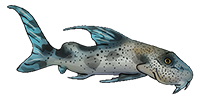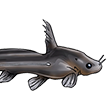will plecs eat lichens
- MDOU
- Posts: 80
- Joined: 14 May 2005, 03:46
- Location 1: far north Queensland, Australia
- Interests: fish.......australian Eel-tailed cats
- Contact:
will plecs eat lichens
i have them growing in one of my tanks (with tons of algae)and i want to know if a plec would safely eat them. would it just be more fibre in its diet?
would there be any side effects?
thanks for any/all help
would there be any side effects?
thanks for any/all help
- MatsP
- Posts: 21038
- Joined: 06 Oct 2004, 13:58
- My articles: 4
- My images: 28
- My cats species list: 117 (i:33, k:0)
- My aquaria list: 12 (i:10)
- My BLogs: 4 (i:0, p:164)
- Spotted: 187
- Location 1: North of Cambridge
- Location 2: England.
There are plenty of plecos that eat all sort of things, so I expect the "right one" would eat Lichens. I'm, however, not sure what the "right one" would be.
I'm sure the algae would be eaten by any generic algae eater (Ancistrus, Hypostomus, Pterogiplichtys(sp?) etc). Lichens is more likely to occur on a piece of wood, so perhaps more likely to be natural diet of a Panaque or former cochliodon member of the Hypostomus family, perhaps.
These are just my thoughts, of course... I've never (to the best of my knowledge) had any lichen in my tanks...
--
Mats
I'm sure the algae would be eaten by any generic algae eater (Ancistrus, Hypostomus, Pterogiplichtys(sp?) etc). Lichens is more likely to occur on a piece of wood, so perhaps more likely to be natural diet of a Panaque or former cochliodon member of the Hypostomus family, perhaps.
These are just my thoughts, of course... I've never (to the best of my knowledge) had any lichen in my tanks...
--
Mats
- MatsP
- Posts: 21038
- Joined: 06 Oct 2004, 13:58
- My articles: 4
- My images: 28
- My cats species list: 117 (i:33, k:0)
- My aquaria list: 12 (i:10)
- My BLogs: 4 (i:0, p:164)
- Spotted: 187
- Location 1: North of Cambridge
- Location 2: England.
- racoll
- Posts: 5258
- Joined: 26 Jan 2004, 12:18
- My articles: 6
- My images: 181
- My catfish: 2
- My cats species list: 2 (i:2, k:0)
- My aquaria list: 1 (i:0)
- Spotted: 238
- Location 1: London
- Location 2: UK
- racoll
- Posts: 5258
- Joined: 26 Jan 2004, 12:18
- My articles: 6
- My images: 181
- My catfish: 2
- My cats species list: 2 (i:2, k:0)
- My aquaria list: 1 (i:0)
- Spotted: 238
- Location 1: London
- Location 2: UK
- racoll
- Posts: 5258
- Joined: 26 Jan 2004, 12:18
- My articles: 6
- My images: 181
- My catfish: 2
- My cats species list: 2 (i:2, k:0)
- My aquaria list: 1 (i:0)
- Spotted: 238
- Location 1: London
- Location 2: UK
I know they can tolerate wet environments, but here's a quote from the Smithsonian Institute's dept for biology's website....
"Some lichens are able to tolerate salt spray on coastal cliffs and periodic inundation by fast-moving streams; however, no lichen is truly aquatic."
I've never heard of an aquatic lichen. as far a i know they are out competed in all aquatic environments by algae.
"Some lichens are able to tolerate salt spray on coastal cliffs and periodic inundation by fast-moving streams; however, no lichen is truly aquatic."
I've never heard of an aquatic lichen. as far a i know they are out competed in all aquatic environments by algae.
-
natefrog
- Posts: 192
- Joined: 15 Apr 2005, 07:26
- My cats species list: 24 (i:0, k:0)
- Location 1: Vancouver, B.C.
A lichen is actually a symbiotic organism that is host fungi living contently with an algal counterpart. Two entirely different kingdoms of organisms and yet in an obligate mutualistic form.
There are obviously aquatic fungus and aquatic algae; however, I am not aware of any aquatic, (whether fresh or marine), lichens. Lichens thrive in marginal terrestrial habitats where their very slow growth does not prevent them from being competitive, this generally means dead branches near the base of very large trees, exposed rock outcroppings, or arctic tundra and alpine escarpments.
Sorry for the nerd report.
There are obviously aquatic fungus and aquatic algae; however, I am not aware of any aquatic, (whether fresh or marine), lichens. Lichens thrive in marginal terrestrial habitats where their very slow growth does not prevent them from being competitive, this generally means dead branches near the base of very large trees, exposed rock outcroppings, or arctic tundra and alpine escarpments.
Sorry for the nerd report.
- racoll
- Posts: 5258
- Joined: 26 Jan 2004, 12:18
- My articles: 6
- My images: 181
- My catfish: 2
- My cats species list: 2 (i:2, k:0)
- My aquaria list: 1 (i:0)
- Spotted: 238
- Location 1: London
- Location 2: UK





